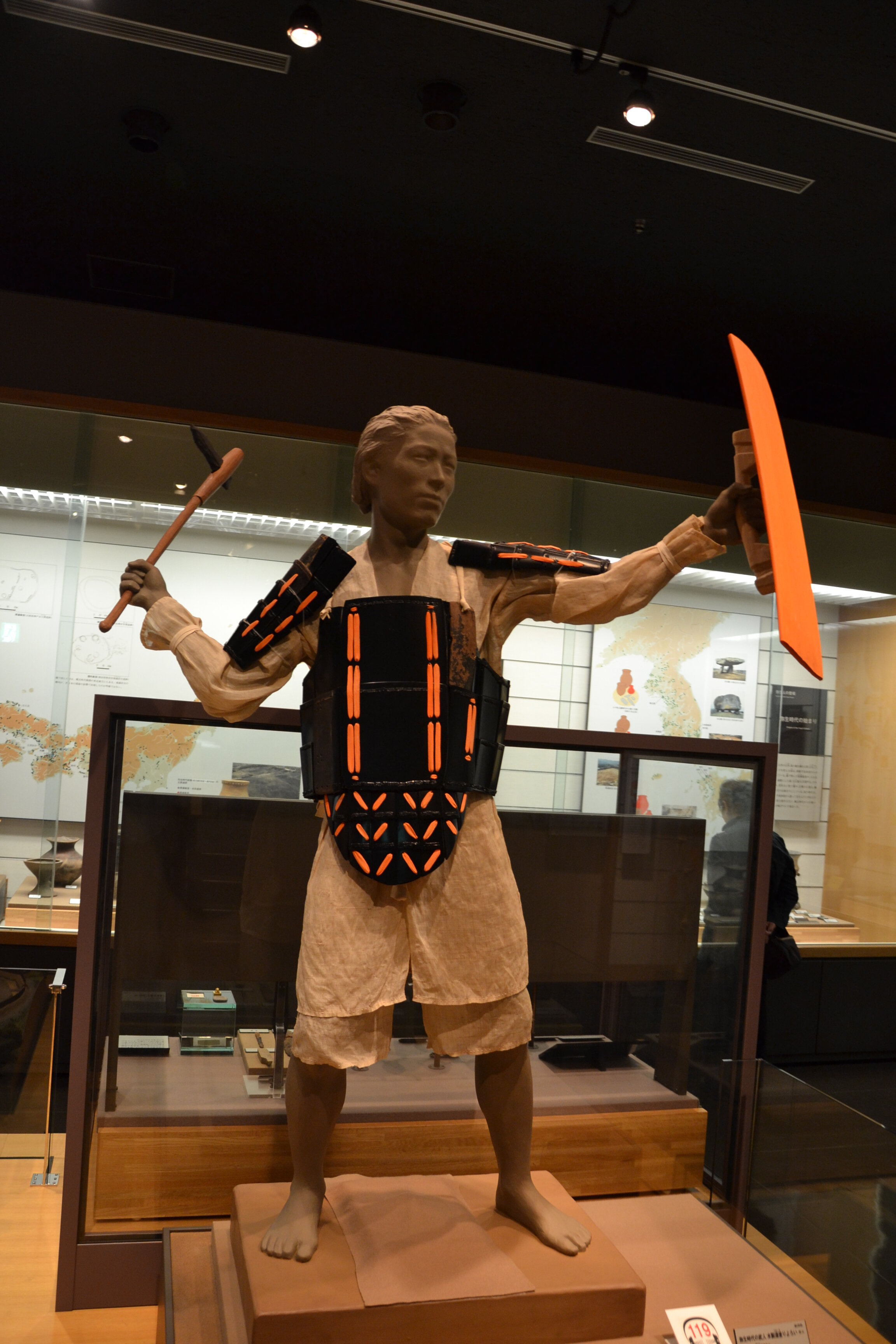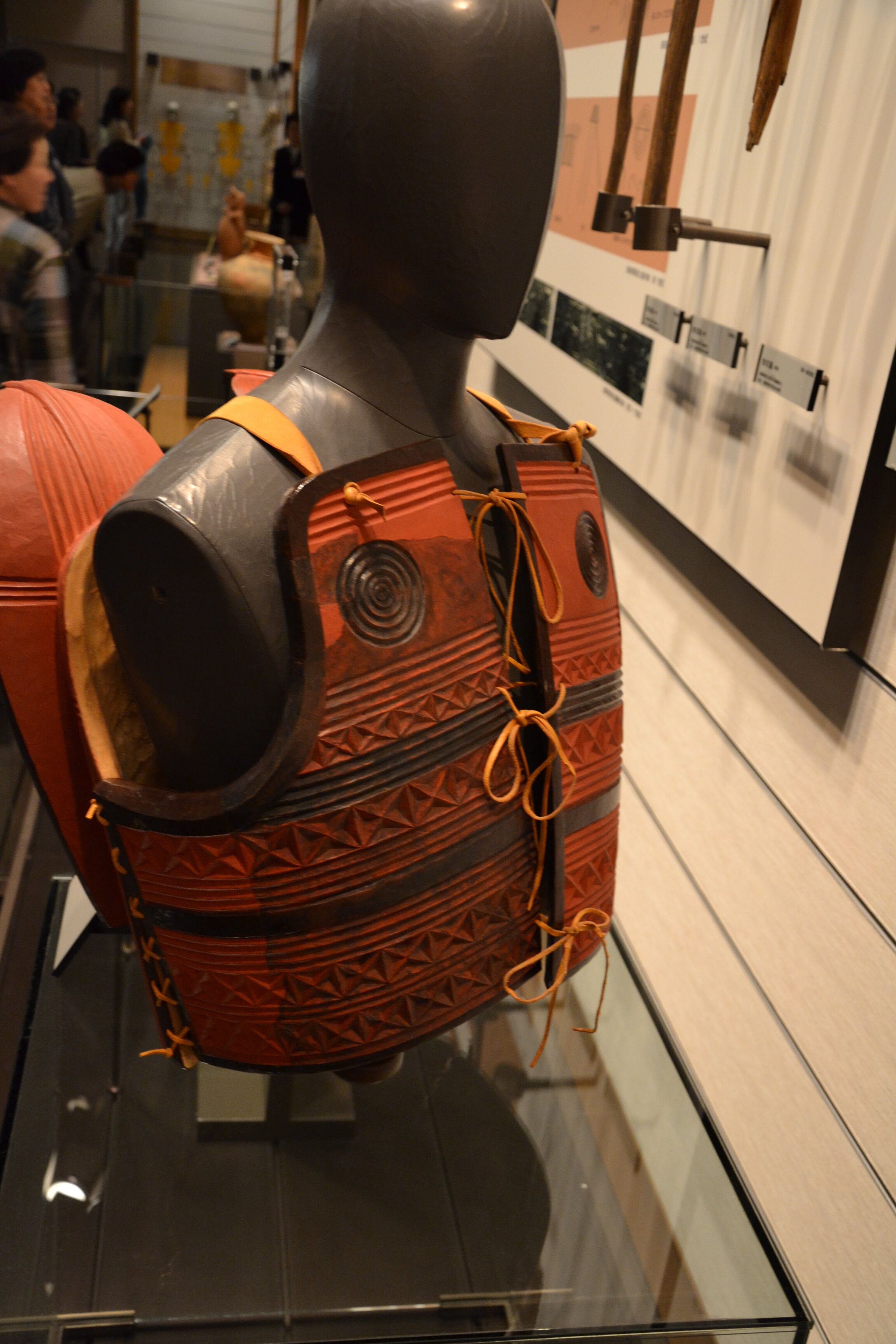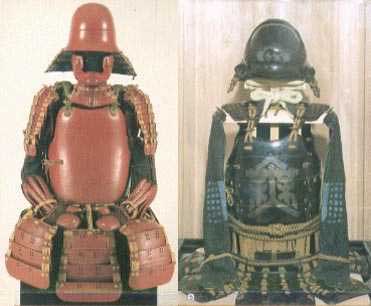Chapter One:
A Brief History of Japanese Armour
This is merely a thumbnail history of the major developments in Japanese armour. For more information on its history, consult the various titles in the bibliography.
Protohistory
Yayoi (弥生時代)
Joshua here. I hesitate to add this in, but I feel it is best to ensure completeness. The earliest period for which we have any evidence of armor in Japan is the Yayoi period, and only two pieces have survived to my knowledge here. The first is made up of a series of lacquered wooden plates, with a purely functional vibe. The other is a cuirass of ornately carved and decorated wood, which may have been as much for decorative or “ritual” purposes as anything else. Neither have enough examples to say how extensively they were used or if they were even typical of armor on the archipelago. They are also centuries apart from any other examples of armor. While the earlier cuirass may seem to be similar to eventual iron armours, it is also similar to many other styles around the world—many people came up with the same idea that protecting the torso is generally a Good Idea when fighting. Therefore it is hard to say definitively that these are in any way related to later Japanese armour other than the fact that they were found on the archipelago.
3rd Century BCE armor, from a reconstruction at the National Museum of Japanese History in Sakura.
2nd Century CE cuirass reconstructed and on display at the National Museum of Japanese History in Sakura.
Kofun (古墳時代)
Quick note: the term “Tankō”, which Tony used extensively here, has been deprecated in some more recent scholarship. You may find that these are referred to instead as a cuirass of vertical or horizontal plates or even a cuirass of triangular plates, usually with information regarding their use in the period. That said, there are still many places that use the term tankō and we’ll maintain that same terminology for the time being. - Joshua L. Badgley, 2021
The earliest Japanese armours that we have consistent examples of were solid metal cuirasses made up of several sections of plate—often roughly triangular in form, though the earliest forms used straight vertical or horizontal lames—which were tightly laced together and usually lacquered against rust. It is not clear what they were originally called; some suggest the term kawara (瓦)—which means “tile”—and others suggest it was simply yoroi (鎧), meaning “armour.” This style of armour has come to be called a tankō (短甲), which means “short armour.” It was hinged on one side or even hingeless and sprung closed, opening up along the center front. The heyday of the tankō was the fourth through sixth centuries. Various additions came and went, including lame-constructed skirt plates and shoulder guards.
Above left: a tankō (cuirass only). Right: A keikō. Left: a tankō (cuirass only). Above right: A keikō.
The tankō was slowly phased out and replaced by a new form of armour which seems to have been inspired by continental models. This new form of armour eclipsed the tankō and set the pattern for the next millennium. The construction was of scale. Since the solid tankō rested on the hips and the new scale armour hung from the shoulders, the historiographical term given to these armours is keikō (挂甲), “hanging armour”.
The general silhouette is hourglass-shaped. Keikō usually opened up in the front, but models resembling ponchos were also known. Despite its early date (sixth through ninth centuries), the keikō was actually a more complex armour than later models, as there could be as many as six or more different types and sizes of scales used in one armour.
Most of what we know about the actual appearance and construction of tankō and keikō is due to the considerable efforts of the late Professor Suenaga Masao, an eminent archaeologist and historian, who painstakingly replicated dozens of different suits of armours after studying the remains excavated from Japanese mound tombs.
The introduction of Buddhism to Japan in the sixth century led to a phase-out of the old burial traditions and the subsequent loss of a great deal of archaeological material. From the last tombs of the eighth and ninth centuries until the oldest extant armour of the eleventh, we have a gap in which we can only surmise—based on what came before and what followed—the forms of armour worn in Japan. One form of keikō, the uchikake-shiki keikō, was clearly the last development of the keikō, and an obvious precursor to the next form of armour.
The Early Middle Ages
The classic Japanese armour, the heavy, square, boxy suit, is now called ō-yoroi (大鎧・“great armour”) although it was originally just called yoroi. The oldest extant ō-yoroi is today just boards made of scales laced together. In other words, it is no longer a solid, wearable piece of armour. We can still tell what it is, and from the wisps of lace remaining in all the suspensory holes, we can also tell that it was a very ornate armour, with six different colors of lacing in a pyramidal pattern. The armour, now in Ōyamazumi Jinja, was made in the first two decades of the tenth century. This armour shows one last remnant of keikō construction: the lacing ran straight down in vertical lines. This vertical lacing also appears in a miniature armourer's model of an ō-yoroi now in the Imperial collection. Armours of only a few decades later developed the down, diagonal, and up again lacing pattern now regarded as standard.
A significant feature of the ō-yoroi is that in cross-section viewed from above, the body forms a letter C, as it is completely open on the right side. Three large, heavy sets of skirt plates of kozane boards hang from it -- one in front, one in back, and one on the left. The right side is protected by a solid metal plate called a waidate, from which hangs the fourth set of skirt plates. Two large square or rectangular shoulder protectors called ō-sode (大袖) that were the size of LP album covers (remember those?) are attached at the shoulder straps. Small rounded flanges stick up from the shoulder straps to give added protection to the side of the neck.
Hanging in the front of the armour and ostensibly protecting the armpits that way were two plates called the sendan-no-ita and kyūbi-no-ita. The sendan resembles a miniature sode, and is worn on the right; the kyūbi is a solid plate, long and narrow, and worn on the left. These are both tied to the shoulder straps at the front of the suit.
Various ō-yoroi. Left: Kon ito odoshi (dark blue laced) ō-yoroi. Middle: “Tatenashi no Yoroi” (a Takeda heirloom, of kozakura [cherry blossom-printed leather] lacing; the name means “shieldless”). Right: Modern reproduction of an akaito(red laced) ō-yoroi.
Earliest ō-yoroi apparently had one fewer row of lames in the front and back of the skirt-plates; no doubt making them more comfortable when riding. Later models, starting around the twelfth century, had a full complement of skirt-plates, but the bottom-most lame in both the front and back was split in the middle to afford the same comfort.
A general in an ō-yoroi typical of the 12-15th centuries. Image courtesy of the Kyoto Costume Museum.
Around the fourteenth century, an armpit plate was added to the left side. Previously, a strip of leather was just folded over the scale heads under the arm, but now a solid plate similar in shape to the munaita (“breastboard”) was laced into place. This served both to give added protection under the armpit and to lend strength to that part of the armour.
The second lame on the back, instead of being laced in the normal manner, is laced“inside out”–that is, the lacing for the next plate emerges from behind it rather than in front, so that it overlaps both the plate above and below instead of just the one above. Central on this plate, aptly called the sakaita (“reversed plate”), is a large, ornate fitting with a ring. This ring is the agemaki-no-kan, from which hangs a huge butterfly-shaped knot (agemaki). Cords coming from the rear of the sode are attached to the “wings” of this knot to help anchor the sode in place.
The entire front of the torso is covered with a printed or patterned leather apron called tsurubashiri (“bowstring-running”). The purpose of this covering is to keep the bowstring from catching on the heads of any of the scales as the warrior fired his primary weapon. Since armoured samurai often shot arrows with their hand along the breast rather than by their ear as was normal (the large helmets typically prevented usual firing methods), this was a logical development. This same leather pattern is used all over the armour: on the shoulder straps, the breast-board, the helmet turnbacks, the sode tops, the visor, etc.
Earliest warriors only wore one armoured sleeve (kote), and that on the left arm. The sleeve's primary purpose was to keep the bulky armour-robe sleeves out of the way of the bow, however, not for protection per se. It wasn't until the thirteenth century or so that matching pairs of armoured sleeves came to be common. The kote was donned before the armour, and tied across the body with long leather straps. The next piece worn was the separate side plate for the right side (waidate). Warriors typically wore these two items, the throat guard (nodowa) and their armoured greaves (suneate) around camp as a sort of “half-dress” armour. These items together are referred to as “kogusoku” or“small armour.”
The ō-yoroi is obviously a bulky and heavy armour. It was also expensive. For retainers and lesser warriors, the dō maru and haramaki were developed. These armours had more skirt plates and fitted closer to the body, omitting the need for a waidate. The dō-maru opens under the right arm; the haramaki opens at the back.
The High Middle Ages
Haramaki dō typical of the 14-15th centuries. Image courtesy of the Kyoto Costume Museum
During the Kamakura Period (1183–1333) the ō-yoroi was the principal armour of those of rank, but samurai found the dō-maru a lighter, more comfortable armour than the ō-yoroi and began to wear it more and more often. By the middle of the Muromachi Period (1333–1568) the ō-yoroi was less commonly met with.
The earliest dō-maru had no armpit plates, just like the earliest ō-yoroi, but all armours began to have them around 1250. The dō-maru was fitted with huge sode as was the ō-yoroi, while the haramaki at first only had small leaf-shaped plates (gyōyō) over the shoulders serving as spaulders. Later, they would be brought forward to cover the cords that held the shoulder straps to the breastboard, replacing the sendan-no-ita and kyūbi-no-ita, and sode were attached to the haramaki.
Thigh armour, called haidate (lit. “thigh shields”) in the form of a split apron of scales, appeared in the mid-thirteenth century, but it was slow to catch on. A variation that appeared early in the next century was a patterned on a knee-length hakama with small plates and mail in front and looked like nothing so much as baggy armoured Bermuda shorts. The split apron pattern would become the dominant form over the centuries, relegating the short hakama variety to the status of curio.
To fill the need for more armour, quicker production was needed, and so sugake odoshi (sparse-point lacing) was born. There are a few famous armours with kebiki-laced torsos and sugake-laced kusazuri (tassets), even though the whole armour is of scale construction. Later, in the first half of the sixteenth century, armourers started to use solid plates instead of boards built up of scales. These were often pierced for full kebiki lacing, but more often than not they were pierced for sugake lacing.
The Late Medieval Period
A dō-maru of the 16th century.
The last half of the sixteenth century is often called the Sengoku Jidai, or Age of Battles. During this period of nearly incessant warfare, various daimyō vied for power and domination over their neighbors and rivals. Some even sought the ultimate prize of becoming the tenkabito, or ruler of the land. Only two people during this age were able to achieve something close to that: Oda Nobunaga (1534–1582) and Toyotomi Hideyoshi (1536–1598).
These five decades saw more developments, innovations, and refinements with armour than all the previous five centuries. Armour underwent a sort of entropy: from fully-laced scales, to sparse-laced scales, to sparse-laced lames, to riveted lames, to solid plates. Each of these steps meant the armours were cheaper and quicker to build than the models that came before them.
One of the greatest influences on armour in this period was the matchlock arquebus, called in Japanese teppō, tanegashima, or hinawa-jū (the first term was probably the most frequently met with in Period.) This necessitated heavier, shot-proof armours for those who could afford them. To this end, solid cuirasses of heavy, thick plates appeared on the scene. Many surviving examples have multiple proof marks indicative of the armourer's skill.
Three armours of the late 16th century. All are ni-mai dō (clamshell armours).
It has been suggested by some armour historians that the solidly riveted clamshell cuirasses—and cuirasses of single-plate breast-and-back construction—were inspired by the European armours. Be that as it may, it was nevertheless the next logical step in the development of Japanese armour.
Armours of European origin and those modeled on European armours became popular status symbols. These armours were, of course, highly modified to suit Japanese tastes until virtually only the cuirass and helmet remained. Even these were “Japanified.” To the cuirass was added Japanese-style skirtplates, and the helmet was turned back-to-front and a lamellar nape guard was added.
Samurai had a great many styles to choose from when it came to arm and leg armour. This period, more than any other, provided true variety, both in terms of actual style and in terms of decoration. For changes in the cuirass, see the chapter “The Dō”
Two armours typical of those worn by retainers. On the left is a hotoke dō, and on the right an okegawa dō.
After 1600
Armourers developed many armours after 1600 that were totally unsuited to the battlefied. This was during the Pax Tokugawa, when war had vanished from daily life. Unfortunately, most of the armour that survives in museums and collections today date from this period. If one is unfamiliar with the changes that were introduced, it would be easy to accidentally recreate a post-Period (i.e. post-1600s) piece. To avoid this, I suggest attempting to become as familiar as possible with historical armours.
In 1700, the scholar, historian, and philosopher Arai Hakuseki wrote a treatise glorifying the “ancient” forms of armour (specifically styles dating back to before 1300). Hakuseki decried the fact that most armourers had forgotten how to make them and that people had forgotten how to wear them. His book resulted in a renaissance of older styles — albeit filtered through a more modern sensibility. This produced some wonderfully eccentric suits and not a few downright abominations.
In 1799, armour historian Sakakibara Kōzan was prompted to write a treatise recalling the martial use of armour in which he decried the trend toward antiquarian armours made for the sake of antiquarianism. His book resulted in a second about-face in armour design, and again the armourers began to produce utilitarian and battle-worthy suits common to the sixteenth century.





![Various ō-yoroi. Left: Kon ito odoshi (dark blue laced) ō-yoroi. Middle: “Tatenashi no Yoroi” (a Takeda heirloom, of kozakura [cherry blossom-printed leather] lacing; the name means “shieldless”). Right: Modern reproduction of an akaito(red laced) ō…](https://images.squarespace-cdn.com/content/v1/5d1a2aa7e7ccfd0001a4f03d/1562006953516-JH4WA4GHC9LFCIRCW3ZC/oyoroi.jpg)




